Nerine Dorman's Blog, page 91
October 29, 2012
Asylum Playing Cards #guest
I've always got my eye out for wicked graphics, and when Milan dropped me a mail a few weeks ago, I couldn't resist giving a little splash on my blog... So over to you, Milan! (PS, I admit I have a huge soft spot for Eastern European artists). And, who knows, maybe one day I can convince Milan to do some work for my book covers, what do you think?
* * * *
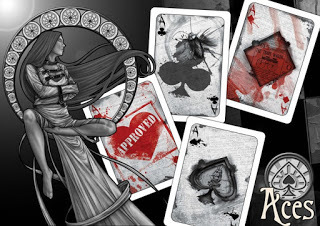
Immerse yourself in the cozy feel of a straitjacket…
Relish the embrace of inexplicably long sleeves…
Discover the comforts held by the tenant of a padded room…
ASYLUM.
Story about Asylum begins 27 year ago on Friday 13th, December 1985, when I was born. Even with this prophetic and symbolic birth date in mind, nobody could have predicted that this bulky baby's size would someday be in direct proportion to my lack of common sense and amount of defiance in adulthood. Since my earliest childhood days, I have displayed a tendency towards artistic expression and a propensity for hedonist doctrines. Childhood was quite jauntily.
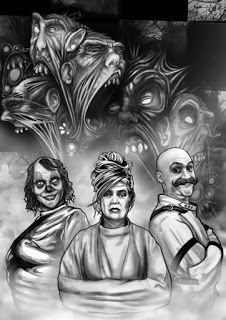 Every fairy tale, however, comes with a plot twist. With growth and maturity came a new understanding of time and space. Ever-deteriorating economical and political circumstances led to the realization that the anatomical-geographical location of Serbia could most accurately be compared to the rectal region of the cosmos. Along with war years, inflation and sanctions forced upon the country came about the first personal sanctions pertaining to my interests. Comic books went out of print, cartoons were taken off the air, and my penchant for drawing had to be reined in. Serbia, phonetically often mistaken for Siberia, was equally cold in its attitude towards the arts. During the two decades of instant-warfare and frequent regime changes (from communism to quasi-democracy and back), artistic pursuits took a back-seat to the more popular pastimes of the working class. Art could, at best, be considered a hobby, but by no means a profession. Wasn't the Asylum natural and logical response to all these circumstances?
Every fairy tale, however, comes with a plot twist. With growth and maturity came a new understanding of time and space. Ever-deteriorating economical and political circumstances led to the realization that the anatomical-geographical location of Serbia could most accurately be compared to the rectal region of the cosmos. Along with war years, inflation and sanctions forced upon the country came about the first personal sanctions pertaining to my interests. Comic books went out of print, cartoons were taken off the air, and my penchant for drawing had to be reined in. Serbia, phonetically often mistaken for Siberia, was equally cold in its attitude towards the arts. During the two decades of instant-warfare and frequent regime changes (from communism to quasi-democracy and back), artistic pursuits took a back-seat to the more popular pastimes of the working class. Art could, at best, be considered a hobby, but by no means a profession. Wasn't the Asylum natural and logical response to all these circumstances?
Well, it was time for me to made some changes...
I made the first tentative steps of my professional career on the foreign market, through the publication of an independent publishers, collaborations with underground movie directors, and some jobs in gaming industry. But Asylum, it should be something different - great entrance for the darkish art community, to the country without understanding for that kind of artistic expression. Can we beat the odds?
The inspiration comes from an amalgam of several personal passions: an appreciation for film, a fascination with cards, and the irresistible allure of the Art Nouveau movement, mainly the art of Alphonse Mucha.
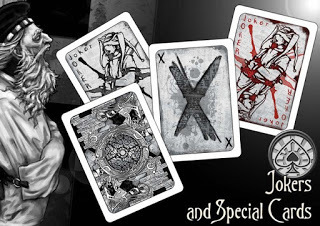 Having spent years working in the gaming industry, mainly on card and board game design, I felt drawn to doing something a bit more traditional. Cards posses a dose of traditionalism which gives them their appeal, and which cannot be replicated in the modern games of the gaming industry, no matter how good their design is. Creating a classic deck makes you a part of history; it gives you the impression of being part of something significant. You are given an opportunity to leave your footprint in time, by redesigning an artifact that was once responsible for people losing their heads, titles, wars, lovers, even empires. By choosing to grapple with creating a deck, you yourself become a part of tradition, and of contemporary court intrigue.
Having spent years working in the gaming industry, mainly on card and board game design, I felt drawn to doing something a bit more traditional. Cards posses a dose of traditionalism which gives them their appeal, and which cannot be replicated in the modern games of the gaming industry, no matter how good their design is. Creating a classic deck makes you a part of history; it gives you the impression of being part of something significant. You are given an opportunity to leave your footprint in time, by redesigning an artifact that was once responsible for people losing their heads, titles, wars, lovers, even empires. By choosing to grapple with creating a deck, you yourself become a part of tradition, and of contemporary court intrigue.
I created a ton of custom art. Even some offers for personal integration of our supporters into Asylum world.
What better way to thank your supporters than to offer them the privilege of merging with history, in a way? We all long to feel special. By giving backers the option of being part of the artwork, I am sharing with them an experience I was also privy to whilst creating the deck. I am giving them the chance to feel like they are becoming a part of tradition.
I like to look at Asylum as a developing organic form. Its quality grows with every new backer. The quality of the product will be directly proportional to the number of backers, so we will create the best deck possible, depending on the possibilities provided by the funds we end up with. We are prepared to sacrifice being economical to preserve quality. Our main asset is precisely that bit of enigma that goes with Asylum – a non-aggressive campaign that true aficionados will be able to appreciate. The core word tied to Asylum is “custom”. It's the most customized deck out there. There are no identical cards, no use of templates. Every suit symbol is different and has been given much attention.
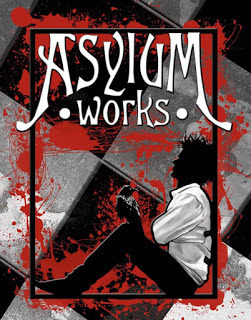 Unsettling… Yet charming.
Unsettling… Yet charming.
Sinister… Yet enticing.
Dark… Yet liberating.
Play with more than cards. Play with emotions. Deceive the mind.
ASYLUM.
Check out the kickstarter for more graphics here... Follow on Facebook, or stalk on Twitter.

* * * *

Immerse yourself in the cozy feel of a straitjacket…
Relish the embrace of inexplicably long sleeves…
Discover the comforts held by the tenant of a padded room…
ASYLUM.
Story about Asylum begins 27 year ago on Friday 13th, December 1985, when I was born. Even with this prophetic and symbolic birth date in mind, nobody could have predicted that this bulky baby's size would someday be in direct proportion to my lack of common sense and amount of defiance in adulthood. Since my earliest childhood days, I have displayed a tendency towards artistic expression and a propensity for hedonist doctrines. Childhood was quite jauntily.
 Every fairy tale, however, comes with a plot twist. With growth and maturity came a new understanding of time and space. Ever-deteriorating economical and political circumstances led to the realization that the anatomical-geographical location of Serbia could most accurately be compared to the rectal region of the cosmos. Along with war years, inflation and sanctions forced upon the country came about the first personal sanctions pertaining to my interests. Comic books went out of print, cartoons were taken off the air, and my penchant for drawing had to be reined in. Serbia, phonetically often mistaken for Siberia, was equally cold in its attitude towards the arts. During the two decades of instant-warfare and frequent regime changes (from communism to quasi-democracy and back), artistic pursuits took a back-seat to the more popular pastimes of the working class. Art could, at best, be considered a hobby, but by no means a profession. Wasn't the Asylum natural and logical response to all these circumstances?
Every fairy tale, however, comes with a plot twist. With growth and maturity came a new understanding of time and space. Ever-deteriorating economical and political circumstances led to the realization that the anatomical-geographical location of Serbia could most accurately be compared to the rectal region of the cosmos. Along with war years, inflation and sanctions forced upon the country came about the first personal sanctions pertaining to my interests. Comic books went out of print, cartoons were taken off the air, and my penchant for drawing had to be reined in. Serbia, phonetically often mistaken for Siberia, was equally cold in its attitude towards the arts. During the two decades of instant-warfare and frequent regime changes (from communism to quasi-democracy and back), artistic pursuits took a back-seat to the more popular pastimes of the working class. Art could, at best, be considered a hobby, but by no means a profession. Wasn't the Asylum natural and logical response to all these circumstances?Well, it was time for me to made some changes...
I made the first tentative steps of my professional career on the foreign market, through the publication of an independent publishers, collaborations with underground movie directors, and some jobs in gaming industry. But Asylum, it should be something different - great entrance for the darkish art community, to the country without understanding for that kind of artistic expression. Can we beat the odds?
The inspiration comes from an amalgam of several personal passions: an appreciation for film, a fascination with cards, and the irresistible allure of the Art Nouveau movement, mainly the art of Alphonse Mucha.
 Having spent years working in the gaming industry, mainly on card and board game design, I felt drawn to doing something a bit more traditional. Cards posses a dose of traditionalism which gives them their appeal, and which cannot be replicated in the modern games of the gaming industry, no matter how good their design is. Creating a classic deck makes you a part of history; it gives you the impression of being part of something significant. You are given an opportunity to leave your footprint in time, by redesigning an artifact that was once responsible for people losing their heads, titles, wars, lovers, even empires. By choosing to grapple with creating a deck, you yourself become a part of tradition, and of contemporary court intrigue.
Having spent years working in the gaming industry, mainly on card and board game design, I felt drawn to doing something a bit more traditional. Cards posses a dose of traditionalism which gives them their appeal, and which cannot be replicated in the modern games of the gaming industry, no matter how good their design is. Creating a classic deck makes you a part of history; it gives you the impression of being part of something significant. You are given an opportunity to leave your footprint in time, by redesigning an artifact that was once responsible for people losing their heads, titles, wars, lovers, even empires. By choosing to grapple with creating a deck, you yourself become a part of tradition, and of contemporary court intrigue.I created a ton of custom art. Even some offers for personal integration of our supporters into Asylum world.
What better way to thank your supporters than to offer them the privilege of merging with history, in a way? We all long to feel special. By giving backers the option of being part of the artwork, I am sharing with them an experience I was also privy to whilst creating the deck. I am giving them the chance to feel like they are becoming a part of tradition.
I like to look at Asylum as a developing organic form. Its quality grows with every new backer. The quality of the product will be directly proportional to the number of backers, so we will create the best deck possible, depending on the possibilities provided by the funds we end up with. We are prepared to sacrifice being economical to preserve quality. Our main asset is precisely that bit of enigma that goes with Asylum – a non-aggressive campaign that true aficionados will be able to appreciate. The core word tied to Asylum is “custom”. It's the most customized deck out there. There are no identical cards, no use of templates. Every suit symbol is different and has been given much attention.
 Unsettling… Yet charming.
Unsettling… Yet charming.Sinister… Yet enticing.
Dark… Yet liberating.
Play with more than cards. Play with emotions. Deceive the mind.
ASYLUM.
Check out the kickstarter for more graphics here... Follow on Facebook, or stalk on Twitter.
Published on October 29, 2012 14:01
October 24, 2012
American Science Fiction: Five Classic Novels 1956-1958 #review
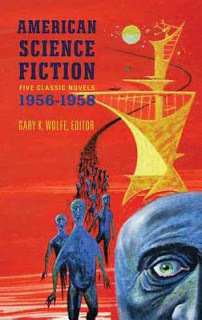 Title: American Science Fiction: Five Classic Novels 1956-1958
Title: American Science Fiction: Five Classic Novels 1956-1958Editor: Gary K Wolfe
Authors: Alfred Bester, James Blish, Algis Budrys, Robert A Heinlen, and Fritz Leiber
Publisher: Library of America, 2012
Buy link
Double Star by Robert A Heinlen
Laurence, or “the great Lorenzo” might not admit it to himself, but he’s a washed-up has-been of an actor not quite succeeding at eking out a living. That is, until he runs into a potential employer who isn’t quite whom he appears to be. Soon Lorenzo is studying for the greatest role he’s likely ever to play, and the stakes have become far higher than he expected. Heinlen explores the notions of the self in double star, and how one person quite literally becomes another. This is a story of personal alchemy, and the psychological changes the protagonist undergoes are far more vast than the ones that are merely skin-deep. Double Star is best described as a futuristic political thriller, and delivers a satisfying close leaving me with much to mull over.
The Stars My Destination by Alfred Bester
This is yet another novel that I’ve heard much about that I’m glad I’ve had an opportunity to read. At the end of the day I’m a bit torn how I feel about the story, and need a bit more time to reflect on how everything fits together. Gully Foyle behaves more as an anti-hero rather than protagonist, though readers can’t help but cheer for his efforts, I’m sure. He comes across a bit as an imp of the perverse, upsetting the cosmic apple cart in the process. He begins his journey at the bottom—a victim—but by the time the story draws to a close he takes on almost godlike proportions. Bester envisions an almost dystopian future, and the concept of jaunting is certainly a fascinating one with far-reaching implications. This story touches on a lot of sociological issues, and makes me think a lot of Ayn Rand’s fiction for some reason. The telling itself leaves me a bit cold, however, as we’re experiencing the world through an omniscient third-person viewpoint. This might, however, be my contemporary tastes coming into play, however. At an rate, The Stars My Destination is a powerful story that will stay with me for a long time.
A Case of Conscience by James Blish
In this novel, Blish answers the question of “What if there were sentient life on another planet?” A thoroughly uncomfortable story that reprises the disastrous consequences of the Spanish conquest of South America, A Case of Conscience examines the repercussions of human contact on the planet of Lithia. All four scientists who numbered among the initial contact expedition to Lithia are changed. Our primary character is a Jesuit priest and scientist, Father Ruez-Sanchez, and the very basis of his faith is called into question by the inhabitants of Lithia, who possess absolutely no faith as a reason for moral guidance. A gift given to him by a well-meaning Lithian in turn has unintended consequences. At a glance, this story pokes at reason vs. faith, but at heart remains a cautionary tale about the dangers of subjective thinking. The world-building of Lithia is hauntingly beautiful, a kind of savage Garden of Eden. This is, as always, a difficult story to read, and one that can definitely lead to lively discussions.
Who? By Algis Budrys
This is another story that’s fascinating to read in the aftermath of the Cold War. Lucas Martino was a genius scientist working on a top-secret project near the enemy lines when things went awry, and he was horribly injured in the resultant explosion. This was exactly the gap the Soviets were looking for, and they picked him up, and patched him up. The only complication for him was that he was almost unidentifiable—much of him had become mechanical. Now he became a bone of contention between the two sides. The Soviet colonel Azarin doesn’t want to let Martino return. What I appreciate about how this story is written is Budrys understands how to use the different viewpoint characters with their unreliable viewpoints to the best effect to create tension. Right up until the last, we are never entirely sure just *who* the mostly mechanical man is.
The Big Time by Fritz Leiber
The last of the novels included in this collection, The Big Time is also my least favourite. To be honest, I struggled to keep up with the cast of characters, terms and settings. I also suspect the fault lies with the reader and not so much the author. That being said, Leiber does a fascinating job of mashing up different eras with his characters, and leaves me guessing the whole time with regard to what’s actually going on. For some bizarre reason, I’m reminded of Anthony Burgess’s A Clockwork Orange in the telling. Still, there is something enigmatic about The Big Time that I enjoyed, and I’m glad I read it.
I’ll be honest, I wouldn’t ordinarily have picked up these novels on their own. When I was a kid I read *a lot* of SF. I didn’t always *get* what I was reading (as in the cultural/historical contexts) but was nonetheless utterly fascinated by the imaginations of these classic authors. So, I’ll admit that the idea to have five classic novels lumped together offered the incentive for me to bite, and consider reading these novels in clump to gain some sort of comparative perspective.
On a very shallow level, I find it fascinating to see authors try to envision future technology. Now, many decades since these novels were published, things have turned out very differently. Small details, such as *how* we communicate, and how we store and retrieve information—I don’t think many could conceive of these possibilities back then, and it shows.
Sociologically speaking, there was so much emphasis on the implied threat of the Cold War, of capitalism vs. communism. Now, in our post-modern world, it’s more the War on Terror that seems to have captured mankind’s fixation. With Soviets out of the picture, we look with a wary eye toward China.
What is also apparent to me, as both editor and reader, is how our language usage has shifted, especially when employing point of view within genre fiction. For that very reason, I did find some of these stories a bit more challenging than others.
Another point of difference is how women are portrayed in SF. For some reason the discrimination didn’t bother me as much when I was a teen exploring classic SF for the first time. But now, the lack of three-dimensional female characters bothered me.
My final verdict: if you’re a serious collector of genre fiction, or are looking to get stuck into a decent collection as a first intro, you can’t do wrong with this selection. There’s a strong cross-section, memorable characters and thought-provoking stories. I appreciated the ride very much and am glad I invested the time in the reading. I might not have gelled with each author’s style as much, but sometimes there are reads that are important as snapshots of a particular zeitgeist, and this anthology says a lot about the hopes and dreams of the 1950s.
Published on October 24, 2012 15:20
October 23, 2012
SCARETOBER SALE
Still haven't read some of my earlier works? Well, as the graphics tell it, Lyrical Press is having a sale for the rest of this month. And these prices really are something else. So, c'mon, my books are totally right there for a Halloween read. Go check 'em out.
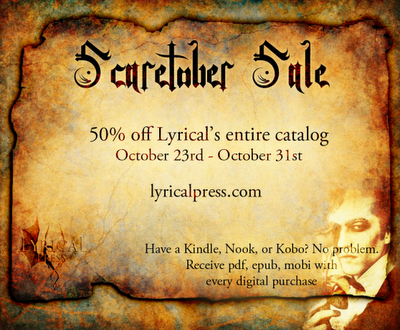
THE NAMAQUALAND BOOK OF THE DEAD
How far will you travel to lay your dead to rest?
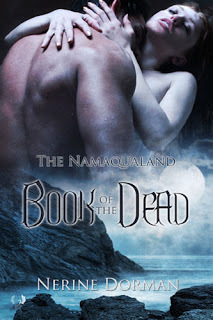 Struggling to come to terms with her boyfriend Aidan’s death, Chloë is ill prepared to deal with the violent murder of his best friend. When tantalizing evidence suggests there is more to Aidan’s apparent death than meets the eye, Chloë will not let her lack of material resources keep her from uncovering the truth, even if the truth proves far more dangerous and with a far more sinister nature than she bargained for.
Struggling to come to terms with her boyfriend Aidan’s death, Chloë is ill prepared to deal with the violent murder of his best friend. When tantalizing evidence suggests there is more to Aidan’s apparent death than meets the eye, Chloë will not let her lack of material resources keep her from uncovering the truth, even if the truth proves far more dangerous and with a far more sinister nature than she bargained for.CONTENT WARNING: Some explicit sexual content and reference to violence
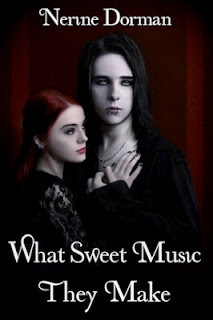 WHAT SWEET MUSIC THEY MAKE
WHAT SWEET MUSIC THEY MAKEMusic brought them together, but can it set them free.
Betrayed by those closest to her, musical prodigy Tersia is heartbroken. She immerses herself in her music, turning her back on love. However, when she notices Severin at one of her performances, the serious, pale young man makes her want to risk her heart again.
Severinís future as a lackey to the vampire Lord Murray has him chafing at his bonds. That is, until he encounters Tersia, whose rare musical talent captivates him. But Severin is not the only one to notice her. Other, darker forces have taken a sinister interest in her potential.
Tersia and Severin can't deny the spark that has ignited between them, but can they overcome the shadows that threaten to smother their trust?
CONTENT WARNING: Some sexual references, drug use.
 HELL'S MUSIC (writing as Therese von Willegen)
HELL'S MUSIC (writing as Therese von Willegen)Sometimes trouble comes in a very appealing package.
It's never nice when your boyfriend leaves you for someone else. It's even more of a slap in the face when he leaves you for a man. Emily Clark has put her wild years and the boyfriend she considered "safe" behind her, ensconcing herself in a Luddite lah-lah land centered on her second-hand bookstore.
But when her self-absorbed sister runs away from home to end up on her doorstep, Emily discovers the past has a funny way of creeping back into her life. And when an alternative musician uses her shop as a hideaway from a nosy reporter, Emily finds herself falling for the enigmatic man. By the time she realizes his celebrity status, it's too late--she's head over heels for Simon van Helsdingen, a
notorious shock-rocker. Not only must she deal with her sister's delinquent ways and their dysfunctional family, but Emily must navigate the stormy seas of
being with a man whose reputation for trouble puts Ozzy Osbourne in the
shadows.
CONTENT WARNING: Sex, drugs and rock & roll
Published on October 23, 2012 11:13
October 22, 2012
A walk in the suicide forest... With Robert James Russell
In June this year I reviewed Sea of Trees by Robert James Russell, a novella so spooky it still haunts me. Curious, well, go take a look at the review here, then come back to this interview. Today I welcome Robert to my world for a little Q&A about the novel, and just in time for Halloween too...
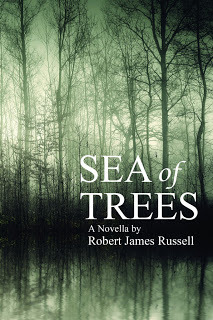 First off, the way you write about the Suicide Forest makes me feel as though you have actually set foot in it. Tell me a little more about what grabbed you about the setting, and how you gave it the ring of authenticity.
First off, the way you write about the Suicide Forest makes me feel as though you have actually set foot in it. Tell me a little more about what grabbed you about the setting, and how you gave it the ring of authenticity.
Well, the setting of the story came from an article I read, which was enough to get me hooked. I started doing research and found the place to be fascinatingly macabre. And during my research I found many pictures—both innocent and gruesome—as well as a few documentaries, that just further piqued my interest to the point where I couldn’t get it out of my head. I mean, it’s so unique—a real-world setting that sees so much spooky stuff, the kind of place that you can’t even imagine is real. But it is. I knew after reading all about it, after seeing those images, that I had to write about it.
To answer the second part of your question, no, I have not been to the actual forest—yet—but I used my experience with forests all over the world (especially in the Midwest United States, South Korea, and Central America) as a template to work from. Besides the varying flora and fauna and other various idiosyncrasies, a forest is a forest, and I think it helps to write from personal experience any time you can. In the case of Aokighara, it’s supernaturally quiet, so I went out into the woods near my house and tried to imagine it being devoid of animal sounds, most noises altogether, really, and how creepy that would be, not to mention the possibility of stumbling across a dead body—ultimately, this is how I attempted to reproduce Aokighara, a place that you feel in the pages of the book as being real…somewhere.
What struck me as specifically poignant were the vignettes of the suicides interspersed by the main narrative. You go through quite a range of scenarios. How did you go about structuring these cases? Were they at all based on existing stories?
Sadly, suicide in general is a major issue in Japan, so I did research of incidents throughout the country and adapted bits and pieces of some real world examples here and there, where they fit into the vignettes and the appropriate themes. For everything else, I did research on Japanese customs and culture in general, why people in Japan commit suicide, what their mindsets are as they set out to do this, as well as studied images and video of Aokigahara—including how people go about killing themselves there—and created the rest of the scenarios as I believe they could have plausibly happened, creating back stories and the build-up to these final moments that, again, fit each vignette’s theme.
The process of research itself must've proved pretty harrowing. Often an author is changed by his or her experience in researching and writing a novel. How did A Sea of Trees impact your life?
Short answer: It gave me a bigger and better perspective—and appreciation—of the world, as well as an understanding of suicide in Japan, why it occurs there in such high numbers, and what’s being done to combat it. Honestly, nothing really prepared me for what I discovered—I had heard previously that suicide was an issue in Japan, but I didn’t know how much of one it really was until I started doing my research. And the forest…pfft. It’s just massive, beautiful, and just so happens to be this “suicide hotspot”, so learning about it, and also about the different cultures and customs in Japan, why people there commit suicide (in some cases, for very different reasons compared to Western countries), it just gave me some real world perspective outside of what I thought I knew going into it…which is never a bad thing, I don’t think.
I know you treat a number of the reasons why people commit suicide in the novel, but in short, can you cover a basic idea?
It was important to me not to diagnose why people commit suicide—that’s not the point of the book, and that would lose sight of some of the other elements. Instead, with the inclusion of the vignettes, I wanted to present lonely people, people who are disconnected from either the world or specific people, and the ramifications of that—how this isolation, this feeling of being lost, or different or misunderstood can compound over time. Obviously not everyone who is lonely commits or attempts to commit suicide, but in these cases, you have extreme situations that drive people to do it, feeling as if it is the only way out, the only way to move on or to find enlightenment. I’m not trying to glamorize it, nor am I trying to dismiss it, but rather, present it as fact, as real life, situations (again, some based on reality) where this would seem like a tangible response that fits in with the large aspects of Junko’s isolation after her sister’s death, her desire to be with her again no matter the cost.

* * * *
Robert James Russell's website: www.robertjamesrussell.com
And his publisher's website...
Buy Sea of Trees off Amazon, Barnes & Noble
Published on October 22, 2012 13:06
October 19, 2012
General authorly buzz and link pimpage
Every once in a while I do feel the urge to do a general bloggish report of my own authorly doings. Most of the time I try to avoid blogging about my own stuff unless there's big new (because there's only so much wankage one can tolerate), but yeah, perhaps today I will because there's some newsworthy happenings occurring.
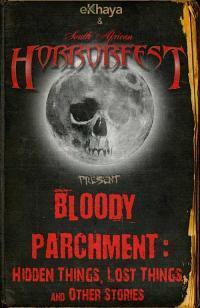 To start, I've got the SA HorrorFest Bloody Parchment event happening in a week's time at the Book Lounge. This is the third year in a row that I've arranged the shenanigans there, and I'd like to take a few moments to say thank you to everyone who's so far helped make this possible. So, a VERY BIG thank you to the folks at the Book Lounge. They put a lot of effort into promoting a culture of bookaholics (which gets my wholehearted approval). If you're ever in their vicinity in Cape Town (71 Roeland Street) do stop by. (PS, you can also buy really good coffee and cupcakes there). Now go check out our event line-up and spread the word via your networks... here. Oh, and if all goes well, we'll have copies of this year's anthology in print, on sale during SA HorrorFest (Chaos willing).
To start, I've got the SA HorrorFest Bloody Parchment event happening in a week's time at the Book Lounge. This is the third year in a row that I've arranged the shenanigans there, and I'd like to take a few moments to say thank you to everyone who's so far helped make this possible. So, a VERY BIG thank you to the folks at the Book Lounge. They put a lot of effort into promoting a culture of bookaholics (which gets my wholehearted approval). If you're ever in their vicinity in Cape Town (71 Roeland Street) do stop by. (PS, you can also buy really good coffee and cupcakes there). Now go check out our event line-up and spread the word via your networks... here. Oh, and if all goes well, we'll have copies of this year's anthology in print, on sale during SA HorrorFest (Chaos willing).
Then, I recently got my rear in gear and sorted out my Amazon Author Page thing. What you can do to help me is go click on the "like" button for my page and books. I will adore you forever and feed you cupcakes. Go check it out here.
I'm still often overwhelmed by some of the reviews that have cropped up for my most recent release, Inkarna. This review had me feeling both awed and humbled that my book had made such an impact on readers; this is the sort of feedback that makes all the anguished hours worthwhile.
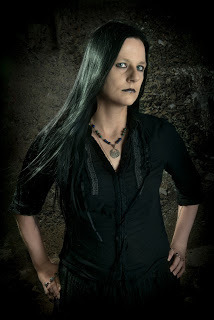 Picture by Leon VisserFor those who've read Inkarna, yes, the sequel is taking shape. All I can say at this point is that we're past the halfway mark and winding up to The Very Horrible Thing that happens before the excrement hits the fan, and it's a very harrowing scene that I'm building up to and possibly one of the most difficult one I've ever had to write so far. Which is possibly half the reason why I've been procrastinating. Yes. I don't want to write this scene. It is horrible beyond all belief. But it has to happen. I'm hoping to have the first draft of Thanatos done by the end of the year, before it goes out to my beta readers. Now go share this link for me, and help me get more sales.
Picture by Leon VisserFor those who've read Inkarna, yes, the sequel is taking shape. All I can say at this point is that we're past the halfway mark and winding up to The Very Horrible Thing that happens before the excrement hits the fan, and it's a very harrowing scene that I'm building up to and possibly one of the most difficult one I've ever had to write so far. Which is possibly half the reason why I've been procrastinating. Yes. I don't want to write this scene. It is horrible beyond all belief. But it has to happen. I'm hoping to have the first draft of Thanatos done by the end of the year, before it goes out to my beta readers. Now go share this link for me, and help me get more sales.
Part of the reason why my writing is so erratic at the moment is because I'm busy with edits for Camdeboo Nights, a YA urban fantasy novel I wrote between Khepera Rising and Khepera Redeemed. It has quite a story attached to it, and has mostly been languishing on my hard drive because it spent at least two years on the submission mill before I almost mothballed it. I sold it to Lyrical Press a year or so ago, and we're sort of nearing the end of the editing cycles. It was also part of the Amazon ABNA/CreateSpace competition, and made it as far as the quarter finals a few years ago. I forget which. So it's not a bad little story (she says), and eventually I'll get round to writing its sequel. A hint: it features little people (like Tyrion), vampires, witches and mages, and it's set in contemporary South Africa. The novel also features a vintage car. My inner petrol head insisted.
Oh, and speaking of my Khepera series. The rights to both novels reverted to me a few months ago, and I'm busy preparing them to return to circulation (albeit with a bit of sprucing up). Yes. New covers. Done by one of South Africa's best illustrators. The novels will be available in both print and assorted electronic formats. So, yeah, it's kinda a case of watch this space for further details.
If you're not already stalking me on Twitter, I'm @nerinedorman ... now go buy my books, okay?
 To start, I've got the SA HorrorFest Bloody Parchment event happening in a week's time at the Book Lounge. This is the third year in a row that I've arranged the shenanigans there, and I'd like to take a few moments to say thank you to everyone who's so far helped make this possible. So, a VERY BIG thank you to the folks at the Book Lounge. They put a lot of effort into promoting a culture of bookaholics (which gets my wholehearted approval). If you're ever in their vicinity in Cape Town (71 Roeland Street) do stop by. (PS, you can also buy really good coffee and cupcakes there). Now go check out our event line-up and spread the word via your networks... here. Oh, and if all goes well, we'll have copies of this year's anthology in print, on sale during SA HorrorFest (Chaos willing).
To start, I've got the SA HorrorFest Bloody Parchment event happening in a week's time at the Book Lounge. This is the third year in a row that I've arranged the shenanigans there, and I'd like to take a few moments to say thank you to everyone who's so far helped make this possible. So, a VERY BIG thank you to the folks at the Book Lounge. They put a lot of effort into promoting a culture of bookaholics (which gets my wholehearted approval). If you're ever in their vicinity in Cape Town (71 Roeland Street) do stop by. (PS, you can also buy really good coffee and cupcakes there). Now go check out our event line-up and spread the word via your networks... here. Oh, and if all goes well, we'll have copies of this year's anthology in print, on sale during SA HorrorFest (Chaos willing).Then, I recently got my rear in gear and sorted out my Amazon Author Page thing. What you can do to help me is go click on the "like" button for my page and books. I will adore you forever and feed you cupcakes. Go check it out here.
I'm still often overwhelmed by some of the reviews that have cropped up for my most recent release, Inkarna. This review had me feeling both awed and humbled that my book had made such an impact on readers; this is the sort of feedback that makes all the anguished hours worthwhile.
 Picture by Leon VisserFor those who've read Inkarna, yes, the sequel is taking shape. All I can say at this point is that we're past the halfway mark and winding up to The Very Horrible Thing that happens before the excrement hits the fan, and it's a very harrowing scene that I'm building up to and possibly one of the most difficult one I've ever had to write so far. Which is possibly half the reason why I've been procrastinating. Yes. I don't want to write this scene. It is horrible beyond all belief. But it has to happen. I'm hoping to have the first draft of Thanatos done by the end of the year, before it goes out to my beta readers. Now go share this link for me, and help me get more sales.
Picture by Leon VisserFor those who've read Inkarna, yes, the sequel is taking shape. All I can say at this point is that we're past the halfway mark and winding up to The Very Horrible Thing that happens before the excrement hits the fan, and it's a very harrowing scene that I'm building up to and possibly one of the most difficult one I've ever had to write so far. Which is possibly half the reason why I've been procrastinating. Yes. I don't want to write this scene. It is horrible beyond all belief. But it has to happen. I'm hoping to have the first draft of Thanatos done by the end of the year, before it goes out to my beta readers. Now go share this link for me, and help me get more sales.Part of the reason why my writing is so erratic at the moment is because I'm busy with edits for Camdeboo Nights, a YA urban fantasy novel I wrote between Khepera Rising and Khepera Redeemed. It has quite a story attached to it, and has mostly been languishing on my hard drive because it spent at least two years on the submission mill before I almost mothballed it. I sold it to Lyrical Press a year or so ago, and we're sort of nearing the end of the editing cycles. It was also part of the Amazon ABNA/CreateSpace competition, and made it as far as the quarter finals a few years ago. I forget which. So it's not a bad little story (she says), and eventually I'll get round to writing its sequel. A hint: it features little people (like Tyrion), vampires, witches and mages, and it's set in contemporary South Africa. The novel also features a vintage car. My inner petrol head insisted.
Oh, and speaking of my Khepera series. The rights to both novels reverted to me a few months ago, and I'm busy preparing them to return to circulation (albeit with a bit of sprucing up). Yes. New covers. Done by one of South Africa's best illustrators. The novels will be available in both print and assorted electronic formats. So, yeah, it's kinda a case of watch this space for further details.
If you're not already stalking me on Twitter, I'm @nerinedorman ... now go buy my books, okay?
Published on October 19, 2012 04:59
October 18, 2012
A Letter from Drago #guest

Horror author SB Knight, who's a previous visitor to my blog, contributes to today's installment. Welcome, Mr Knight, tell us more about your latest offering, Drago's Revenge.
* * * *
A Letter from Drago
My subjects,
You have the unique opportunity today. What is that you ask? Well, it is to hear from me of course. Today I would like to share with you a little about me. First, I am not sure of what you have heard about me and, to be honest; I am not one to care. I suppose it only fair that I give you some background about me before addressing future endeavors. No, I do not have the desire to pen anything concerning my childhood for it is of no concern to you. I will, instead, address a more recent past.
Understand, I had plans for my dear Jocelyn, I still do but that is for later. Unfortunately, there were two who decided to get in my way. Ah, but do not worry, I know where they are and I will soon show them the value of their life…which, in my opinion, is not much. They took her away from me and denied me what is rightfully mine. To think, that red headed menace actually influenced my most trusted assistant and had the audacity to bring his seed into the world.
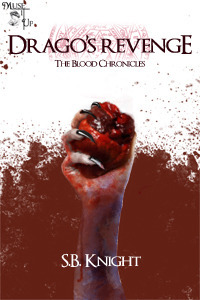
I assure you, I have a plan in place to rid the world of these two and see my goal accomplished. And what a goal it is, I can taste it. It is within my reach and I will have it. Nothing will stop me and all you defy me will be crushed beneath my feet. My apologies, I seemed to have gotten carried away with my desires. Alas, Jocelyn is a setback but there are other ways to see my revenge accomplished. Yes, as much as I detest her, Reba and her medaling has presented me with a unique opportunity. One I do not plan to miss.
This world we now exist in is not as mine. All of you are weak and ripe for domination. It will be my pleasure to oversee the direction of your pitiful life. Of course, if you know the value of your life then perhaps you can be of service to me. If not, and many of you don’t, you will become like all the others. Well, I have given you enough of my time. There are two that I must deal with without hesitation. My revenge will be sweeping. My revenge will be without mercy. My revenge will be complete.
You have been warned, now run and remember the value of your life.
Drago
Blurb: The birth of a child is a time for joy and celebration. For Sam and Reba, it is a time for concern and worry. Concern for what could be and worry for what lurks in the shadows. They both know Reba’s baby, Christian, is special. But Drago waits in the darkness, and he, also, knows how special the child is. He knows what the child’s birth means. Now Drago stalks them, waiting for his moment to strike and claim Christian for his own evil purposes. As he unleashes his sinister plan, Sam and Reba fight to survive and keep their newborn out of his clutches.
Chased by a group of would-be vampires manipulated by Drago, Sam and Reba are forced to abandon their home and find sanctuary in once forgotten locations. But they are not alone in this fight as family and friends arrive. Will it be enough?
Life will be lost, blood will be spilled, painful memories, and emotions will torment minds…all part of Drago’s revenge.
 About the author: Drago’s Revenge is the next step as SB Knight continues to pursue his passion for writing novels that deliver both thrills and chills. His desire is to improve the craft he loves with each novel he writes. He strives to deliver fresh, new ideas and stories in the Dark Fantasy genre. Currently he is writing the third novel of The Blood Chronicles.
About the author: Drago’s Revenge is the next step as SB Knight continues to pursue his passion for writing novels that deliver both thrills and chills. His desire is to improve the craft he loves with each novel he writes. He strives to deliver fresh, new ideas and stories in the Dark Fantasy genre. Currently he is writing the third novel of The Blood Chronicles.When not writing, SB Knight enjoys spending time with his family and being outdoors. During a normal week he can be found on social networks such as Facebook, Twitter, and his blog The New Author. Easily approached, SB Knight enjoys chatting with readers and fans alike. Information about SB Knight, his books, and upcoming projects can be found at www.sb-knight.com.
Born of Blood, released in March of 2012
Drago's Revenge, releases in October 2012
Demathia Rising, releases in March 2013
“Writing novels that inject new blood into the world of Dark Fantasy is my true passion. Vampires, werewolves, and zombies…you only know what you’ve read.”
Links: website , blog, Facebook, Twitter, MuseItUp
Special - From now until October 30 you can PRE-ORDER Drago's Revenge for $4.76 (that's 20% off retail price). PLUS, when you pre-order you get Born of Blood for free! That's right, save 20% AND get a free ebook! Pre-order Drago's Revenge today!
Published on October 18, 2012 13:33
October 17, 2012
Meet Greg Lazarus. #interview
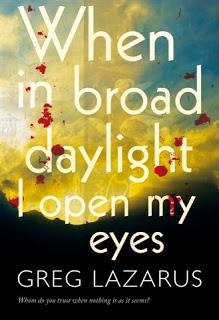 WHEN in Broad Daylight I Open My Eyes
is a recent release by writing duo Greg Fried and Lisa Lazarus, who collaborate under the pen name Greg Lazarus. The novel, a psychological thriller set in Cape Town, explores the emotional entanglements of its complex main characters in the context of the games they
WHEN in Broad Daylight I Open My Eyes
is a recent release by writing duo Greg Fried and Lisa Lazarus, who collaborate under the pen name Greg Lazarus. The novel, a psychological thriller set in Cape Town, explores the emotional entanglements of its complex main characters in the context of the games theyplay, often with tragic consequences.
Underpinning the story is the realisation that everyone has choices, and that real life is very much like a game of chess in which we choose to make particular moves.
When in Broad Daylight I Open My Eyes slowly ratchets up the tension to an ending with a surprise sting. The novel echoes real life; Fried is a philosopher and Lazarus a psychologist, which mirrors career choices held by the characters Kristof and Maria.
To this, Lazarus says: "We think that psychologists and philosophers belong in psychological thrillers. In a thriller, the characters - and the reader, if the book works - keep asking themselves, what's behind the mystery? And that, in different ways, is what philosophers and psychologists do: they try to find out what's really going on."
It follows that the sometimes subtle power games people play should flow naturally in this environment. To a degree, some are aware, others perhaps not so much, that they are being played, which can be highlighted in how Kristof toys with women, or perhaps how the somewhat ominous esoteric Circle of Mystics presents itself to the public.
Lazarus adds: "Some of the characters do try to manipulate each other to achieve their own ends. As Tversky warns potential recruits to the Circle of Mystics, 'You might ask who it is that you ought to suspect. Beware of smiley faces and kind words. Watch out especially for those who go on about how they're concerned about you, how they want to help you, how they cherish you.' Of course, some figures, for example Kristof, are more purposefully manipulative than others. And certain characters, as a result of their own vulnerabilities, get taken for a ride."
 Greg Fried and Lisa Lazarus.Half the joys of a writing partnership is having someone to bounce ideas off. With regard to the process, Lazarus says: "When we wrote the first draft, we didn't talk enough about the book: one of us would write a
Greg Fried and Lisa Lazarus.Half the joys of a writing partnership is having someone to bounce ideas off. With regard to the process, Lazarus says: "When we wrote the first draft, we didn't talk enough about the book: one of us would write achapter, we'd speak briefly, and then the other one would get to work. The result was a disjointed mess! After that, we learnt to discuss everything - story, character, tone - before writing and while writing. It takes a lot of talking before two people are living in the same imaginary world. Once we both had a feel for the world of our story, we found our joint ideas were richer than whatever we managed to come up with alone."
During the writing process, Fried and Lazarus did find that there was a degree of overlapping, in which they began to understand and integrate the other's ideas. Lazarus elaborates: "For the first draft, we were each in
charge of one main character, but after that, both of us worked on everything. So we wouldn't say that either main character 'belongs' to one of us. Each of us learnt to write in the tone and style of all the figures in the novel.
"As we developed the characters, some of them changed a lot. For example, a meek mystic turned into a hardnosed businessman."
And characters are well-rounded, their redeeming qualities tempered by a healthy dose of casual cruelty toward others. Kristof, for instance, bears a lot of animosity toward women, perhaps even a mother/whore complex, whereas Maria's issues with men possibly relate to an absent father.
Lazarus says: "We were interested in the way that people pretend - to others, to themselves - that their motives and characteristics are much finer than they really are. For example, we have Kristof, who presents
himself as cultured and caring, but is also a predator; and Maria, who thinks of herself as sensitive and insightful, yet fails to understand why, in her relationships with men, she is the prey."
Those who are enchanted by When in Broad Daylight I First Open My Eyes, wherein some characters even possess the ability to dominate from beyond the grave, will be glad to know that the writing duo are working on another novel.
Published on October 17, 2012 01:52
October 15, 2012
I stick to black to avoid today’s fashion nonsense
 I’m starting to sound like my grandmother when she used to bitch about the clothing “those young people are wearing”. There’s only one problem with the picture. “Those young people” are wearing the clothing my ouma wore in 1985. I kid you not. What is wrong with me? All I want is a nice (plain) black skirt or plainish lacy dress. Stuff I can wear to work or when I go out. Fabric that won’t allow the bloodstains to show.
I’m starting to sound like my grandmother when she used to bitch about the clothing “those young people are wearing”. There’s only one problem with the picture. “Those young people” are wearing the clothing my ouma wore in 1985. I kid you not. What is wrong with me? All I want is a nice (plain) black skirt or plainish lacy dress. Stuff I can wear to work or when I go out. Fabric that won’t allow the bloodstains to show.Okay, only joking about that last sentence.
Over the years the kindergoth that I was during the mid 1990s has become relatively tame. She wears her purple army boots with long satin skirts and Type O Negative T-shirts to work and to the occasional live gig. She likes hoodies. Plainish ones. To be honest, I’m not fashion conscious. I have an ancient pair of guys’ New Rocks which I wear when I help on film sets. Most of my clothing items are hand-me-downs from friends who either degothed themselves or picked up too much weight.
I suppose I should think myself lucky. I’m skinnier now than I was when I lived with ma and pa. In fact, I fear I shall weigh 65kg till the day I die. But that’s okay. I can deal with that. It means I still wear clothing from my college days (at least the items that are not full of holes). With a wardrobe largely consisting of garments in sombre tones of black on black, with occasional highlights of pink, green or purple, I’m one of those sad folks who can throw just about anything on and not have to worry about co-ordinating.
I exist in a happy little bubble of drabness. Except I realised the other day that I needed a few items of clothing and would have to enter a store. Only now I wish I had never set foot across the threshold of The Big Retail Outlet We Won’t Name.
I knew I was in trouble when I saw the customer who had somehow combined neon orange jeans with a shocking magenta minidress, a luminous yellow snood thing and screaming-green bolero jacket. It was like passing a car crash. I couldn’t help but stare. And I’m not making this description up. Another customer caught sight of my stricken expression and matched it with hers before we traded wry smiles and went our separate ways.
Huge signs in bold red proclaimed a sale on the third floor. I shrugged mentally. It couldn’t hurt to look, could it? I was wrong. I lasted all of five minutes, my eyes burning and my stomach roiling. How can fashion buyers get it so wrong? Baggy purple floral prints that look like a cross between a granny dress and a nightgown. Leopard-print jeans. Who in their right mind wears tight gold leopard-print jeans? Someone who cruises street corners in the red light district?
The women’s section wasn’t much better. I’m almost certain the buyers raided my late grandmother’s cupboard. I thought horizontal navy, white and green stripes were pretty grim during the eighties. Thirty years later, I haven’t changed my mind. Let’s not talk about the dashes of luminous orange and yellow that grabbed me by the eyeballs. In the nineties we, who survived poodle perms, neon alice bands, shoulder pads and leg warmers swore, “Never again”. We swore this for a reason. Evidently anyone born after 1994 hasn’t learnt why.
I was fortunate to escape the “fashion” retailer, and vowed to go find that dinky little second-hand and vintage clothing store on Loop Street. I’m not certain, but I think that lovely outlet has become a Somali corner café, just like every other corner store in the centre of Cape Town. Ah well. Maybe I could dash into two Slightly Smaller Retail Outlets We Won’t Name before my lunch hour was over. Suffice to say, I’ve concluded that there’s no hope for humanity this summer.
Puffy jackets. Leopard print. Gold sequins. More neon shades. Vomitous combinations of contrasting colours. I know retro’s cool but what about the rest of us who just want “normal” clothes? Actually, I don’t even think I know what normal is any more. I’ve recently started crocheting in the vain hope of creating clothing I actually would wear.
So, now you know why I still wear black, and I’m always happy to be gloriously out of fashion. At least all my clothing matches and I don’t look like my fashion was selected by a colour-blind monkey who’s imbibed vast quantities of illegal hallucinogenic substances. And, guess what? I’ll still wear black next year. And I’ll be laughing at all of you with your cot death baby blue off-the-shoulder knee-length sweaters with the silver polka dots over hernia-pink tights and wedges that make you look like you’re constantly about to fall over. You dig?
* * * *
This editorial column appeared in the Sunday Independent Life supplement on October 14.
Published on October 15, 2012 00:42
October 12, 2012
LOOT! #amreading
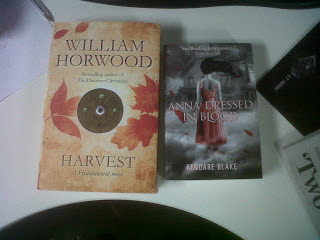
Very happy to receive some new loot on my desk today to add to my TBR pile. I'll be reviewing William Horwood's Harvest and Kendare Blake's Anna Dressed in Blood soon.
Published on October 12, 2012 01:15
October 10, 2012
Pay It Forward: It Takes a Village to Sell a Book by Paula R Stiles #guest
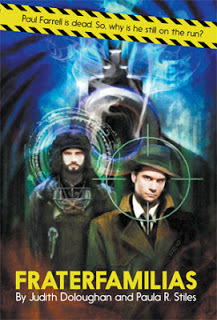 Today I welcome Paula R Stiles, editor and author... Over to you, Paula!
Today I welcome Paula R Stiles, editor and author... Over to you, Paula!
* * * *
As the editor of an online horror zine and micropress, Innsmouth Free Press, I'm on a lot of social networking sites. Naturally, most people posting on them in the writing field are looking to sell something – namely, books and magazines. Stephen King wrote in his excellent book, On Writing, that any new writer who wants to succeed should build up a peer group of other writers at about the same level, as a mutual cheering squad. I would argue that you also want to hang out with writers far ahead of you and writers just starting out, but his advice, in its basic principle, is sound. Writers are a valuable resource for each other. Too often, it's one we squander.
I often see complaints about writers doing “favors” for each other, as if it's a bad thing. I've been advised not to do reviews (I do them all the time), not to “pimp” myself out for blurbs (I do them all the time, too, if someone asks), not to “like” other writers on Facebook and other venues (Ask me and I'll do it). I see a lot of debate about what constitutes a “meaningful” review, a “good” blurb (Hint: A blurb is not the same thing as a review), whether “liking” someone on Facebook is good promotion or just a high school popularity contest. The simplest, quickest answer to this is: Good promotion is whatever sells your book.
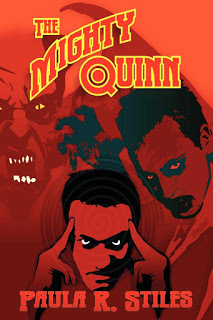 Why should you do these favors for other writers? Aren't they fake? I would argue that no, they are not. Writers interact with two main groups in their audience – other writers and readers. Writers have a direct influence in that they write their own work and are usually more willing to donate money to fundraisers for magazines or buy other writers' books. Readers are like the lurkers on a message board. They don't directly participate, but they influence the conversation by hits on sites, comments on posts, books and magazines that they buy. You want a mix of both and you'll want to talk to both on a regular basis. Writer friends are great and most obvious in their support, but loyal readers are gold.
Why should you do these favors for other writers? Aren't they fake? I would argue that no, they are not. Writers interact with two main groups in their audience – other writers and readers. Writers have a direct influence in that they write their own work and are usually more willing to donate money to fundraisers for magazines or buy other writers' books. Readers are like the lurkers on a message board. They don't directly participate, but they influence the conversation by hits on sites, comments on posts, books and magazines that they buy. You want a mix of both and you'll want to talk to both on a regular basis. Writer friends are great and most obvious in their support, but loyal readers are gold.How do you win over fellow writers? By exchanging favors (more like promotional tasks) with them that you can't do on your own. You're all there to sell books and you don't have to stomp all over the competition to do it. Playing nice is, of course, altruistic and the right thing to do (as your mother would tell you), but it also has practical advantages. It's all very well to complain about that person who is out there hustling books all over the place (Nobody wants to be that jerk who has nothing to contribute but a commercial), but your book does need to get out there and nobody is obligated to put it out but you. Authors who write the thing and then sit back, expecting the world to beat a path to their door, are lazy jerks who are expecting everyone else to do all the work of promoting it. Uh-uh. You're the one it matters to the most. You promote it.
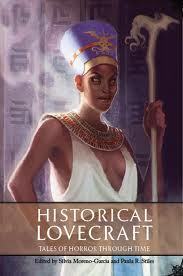 How do you win over readers? By writing great books they want to read, of course, but also by treating your audience well, both fellow writers and readers. You don't have to give in to every demand from your audience, but you shouldn't be a jerk, either. Sure, there are jerks who write well and succeed, but there are a lot of books out there. And your audience can always go with someone who writes just as well as you do, but who isn't a jerk.
How do you win over readers? By writing great books they want to read, of course, but also by treating your audience well, both fellow writers and readers. You don't have to give in to every demand from your audience, but you shouldn't be a jerk, either. Sure, there are jerks who write well and succeed, but there are a lot of books out there. And your audience can always go with someone who writes just as well as you do, but who isn't a jerk.Group promotion is especially important for anyone outside of the main publishing industry. I don't just mean the big New York publishers. I mean anyone outside of the United States. Canada and Britain are fairly well-connected to the American publishing industry, albeit not in a way that favors regional or ethnic authors very well, but Australia, China, India, Africa? Not so much. In fact, one could say that these regions are almost invisible to American audiences unless they shout – and individual writers need a collective voice for that, even in this day and age of the Internet.
Finally, in light of all the recent kerfuffle about “bought” reviews and reviews by “friends” (or self reviews, which are ultimately just mental masturbation), when is a review “meaningful”? Readers rate this differently from writers who write the review or read one for their own book. Writers need exposure. They need to get the word out, but they're up against a thousand other books with the same problem.
 Readers, meanwhile, just want to know what there is to read and whether your book is worth checking out. Whether or not the review is “nice” is beside the point to them (So, guess what? Writing a nasty review about a competitor's work to sabotage them will only backfire on you). Think how you determine what you want to read. Do you use a review that is always positive and upbeat, or do you use a review (negative or not) that tells you what you want to see in a book? The answer is the latter.
Readers, meanwhile, just want to know what there is to read and whether your book is worth checking out. Whether or not the review is “nice” is beside the point to them (So, guess what? Writing a nasty review about a competitor's work to sabotage them will only backfire on you). Think how you determine what you want to read. Do you use a review that is always positive and upbeat, or do you use a review (negative or not) that tells you what you want to see in a book? The answer is the latter.A positive review makes a writer feel better, but an informative review, positive or negative, sells the book. Some readers even prefer harsh reviews because they provide more detailed information that the reviewer marshals to make his/her points about the book. Just because the reviewer didn't like it doesn't mean a reader checking out the review will feel the same way. And uninformative negative reviews of the “It sucks!” variety tend to be just ignored. So, a review that makes you go, “Ouch!” can still sell your book. Keep that in mind the next time you see a critical review and then stifle your angry retort. That reviewer is doing you a favor.
BIO
Paula R Stiles is a random citizen of the world who has sold SF, fantasy and horror to Strange Horizons, Writers of the Future, Jim Baen’s Universe, Arkham Tales, and History is Dead, among others. She also has published a cowritten mystery/SF novel, Fraterfamilias, and a non-fiction book of medieval history, Templar Convivencia: Templars and Their Associates in 12th and 13th Century Iberia. She edits the Lovecraftian online zine and micropress, Innsmouth Free Press, for her sins (which are many). Her urban fantasy novel, The Mighty Quinn, has recently been unleashed by Dark Continents onto the world. Your latest flu shot won't help. You can find and berate her at: http://thesnowleopard.net.
Published on October 10, 2012 12:43



